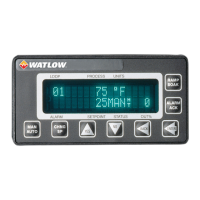CLS200 Series User’s Guide
Chapter 2: Installation
27
Symptoms of RFI/EMI
If your controller displays the following symptoms, suspect EMI:
• The controller’s display blanks out and then reenergizes as if power had been turned off for
a moment.
• The process variable does not display correctly.
Noise may also damage the digital output circuit—so digital outputs will not turn on. If the digital
output circuit is damaged, return the controller to Watlow for repair.
Avoiding RFI/EMI
To avoid or eliminate most RFI/EMI noise problems:
• Connect the CLS200 case to earth ground. The CLS200 system includes noise suppression
circuitry. This circuitry requires proper grounding.
• Separate the 120 or 240VAC power leads from the low-level input and output leads
connected to the CLS200 series controller. Do not run the digital I/O or control output leads in
bundles with ac wires.
• Where possible, use solid-state relays (SSRs) instead of electromechanical relays. If you must
use electromechanical relays, try to avoid mounting them in the same panel as the CLS200
series equipment.
• If you must use electromechanical relays and you must place them in a panel with CLS200
series equipment, use a 0.01 microfarad capacitor rated at 1000VAC (or higher) in series with
a 47Ω, 0.5 watt resistor across the normally-open contacts of the relay load. This is known as
a snubber network and can reduce the amount of electrical noise.
• You can use other voltage suppression devices, but they are not usually required. For
instance, you can place a metal oxide varistor (MOV) rated at 130VAC for 120VAC control
circuits across the load, which limits the peak ac voltage to about 180VAC. You can also
place a transorb (back-to-back zener diodes) across the digital output, which limits the digital
output voltage.
Additional Recommendations for a Noise Immune System
It is strongly recommended that you:
• Isolate outputs through solid-state relays, where possible.
• Isolate RTDs or “bridge” type inputs from ground.
• Isolate digital inputs from ground through solid state relays. If this is not possible, then make
sure the digital input is the only connection to earth ground other than the chassis ground.
• If you are using EIA/TIA-232 from a non-isolated host, either (1) do not connect any
other power common point to earth ground, or (2) use an optical isolator in the
communications line.

